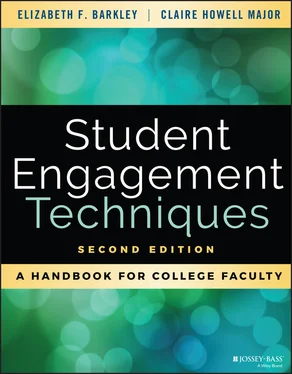Elizabeth F. Barkley - Student Engagement Techniques
Здесь есть возможность читать онлайн «Elizabeth F. Barkley - Student Engagement Techniques» — ознакомительный отрывок электронной книги совершенно бесплатно, а после прочтения отрывка купить полную версию. В некоторых случаях можно слушать аудио, скачать через торрент в формате fb2 и присутствует краткое содержание. Жанр: unrecognised, на английском языке. Описание произведения, (предисловие) а так же отзывы посетителей доступны на портале библиотеки ЛибКат.
- Название:Student Engagement Techniques
- Автор:
- Жанр:
- Год:неизвестен
- ISBN:нет данных
- Рейтинг книги:3 / 5. Голосов: 1
-
Избранное:Добавить в избранное
- Отзывы:
-
Ваша оценка:
- 60
- 1
- 2
- 3
- 4
- 5
Student Engagement Techniques: краткое содержание, описание и аннотация
Предлагаем к чтению аннотацию, описание, краткое содержание или предисловие (зависит от того, что написал сам автор книги «Student Engagement Techniques»). Если вы не нашли необходимую информацию о книге — напишите в комментариях, мы постараемся отыскать её.
— — — —
Student Engagement Techniques
"Student Engagement Techniques
"Student Engagement Techniques
"This book is an essential resource for faculty seeking to better engage with their students. Anyone seeking a clear, research-based, and actionable guide needs a copy of Student Engagement Techniques on their shelf!"
Student Engagement Techniques — читать онлайн ознакомительный отрывок
Ниже представлен текст книги, разбитый по страницам. Система сохранения места последней прочитанной страницы, позволяет с удобством читать онлайн бесплатно книгу «Student Engagement Techniques», без необходимости каждый раз заново искать на чём Вы остановились. Поставьте закладку, и сможете в любой момент перейти на страницу, на которой закончили чтение.
Интервал:
Закладка:
The Affective Domain
How students feel—about life, about themselves, about what teachers are trying to teach them—plays a critical role in how they learn. Many educators believe motivation, sometimes defined as the feeling of interest or enthusiasm that makes somebody want to do something, is at the heart of student engagement. As Wlodkowski (2008) points out, “To put it quite simply, when there is no motivation to learn, there is no learning … people motivated to learn are more likely to do things they believe will help them learn” (pp. 5–6). Sharing Wlodkowski's emphasis on the importance of motivation, Lee Shulman (2002) pairs motivation with engagement and identifies the two as the first stage in his table of learning (p. 2). Yet students' emotions have been the least studied and most overlooked aspect of classroom teaching.
Although Bloom's taxonomy of the cognitive domain has been one of the most influential constructs in education, far fewer teachers are aware of the taxonomy of the affective domain (see T/S 48, “Incorporate Multiple Domains When Identifying Learning Goals”). Most teachers put their efforts into designing goals and activities that help students achieve cognitive outcomes; few instructors identify or assess learning goals having to do with feelings.
Affect is the emotion associated with an idea or action, thus the affective domain includes our feelings, values, enthusiasms, and attitudes. We discussed the function of neurons and neuronal networks from primarily a cognitive perspective (see Chapter 3), so let us take a moment to explore their role in affect. From a neuroscientific perspective, affect is just as much a part of the brain's neuronal network as cognition. Although scientists used to think emotion was centered in the specific limbic area of the brain, Ratey (2002) observes that now research demonstrates “Emotion is not the conveniently isolated brain function that once we were taught. Emotion is messy, complicated, primitive, and undefined because it's all over the place, intertwined with cognition and physiology” (pp. 223–224). Even though our emotional responses are distributed throughout the brain and body, scientists are starting to figure out how the different components are interacting.
Affect and Memory
At the center of the brain, sandwiched between the two temporal lobes, is the limbic region, an area that consists of a group of structures that regulate our emotions and our memory. Two of these—the hippocampus and the amygdala—perform essential roles in learning. The hippocampus plays a major role in consolidating learning and in controlling how memories are stored. Memories are not stored as a whole in one place; they are distributed throughout the brain in a dynamic, interactive system that the hippocampus helps retrieve and reassemble as necessary.
At the bottom of the hippocampus is a smaller structure called the amygdala. Since we are bombarded with perceptual stimuli every moment of our lives, our brain must determine what is most important so that we are not “on overload.” The amygdala is a vigilant monitor that reacts to experiences before we consciously understand them—especially to those that appear threatening or dangerous—by priming the brain to be alert for possible action. The amygdala performs this function by comparing incoming information with long-term memories from past experience, and then deciding what the body should do about it. The “fight or flight” response is an emotional response that happens before one's thinking brain, the cortex, can get involved because stopping to think would take too long before a needed decision was made (Newquist, 2004; Ratey, 2002; Wlodkowski, 2008).
When we are not in life-threatening situations, the hippocampus and the amygdala work together to help us “read” nonverbal information, interpret social situations, and understand and deal with our own and other's feelings. The upper cortex, which involves our thinking brain, and the lower limbic structures, which involve our emotions, are in continuous communication with each other. Interestingly, there are many more connections from the small emotional limbic center into the large logical and rational cortical centers than the reverse. When emotions overwhelm us (we become too scared or too excited) we can usually use the reasoning centers in our cortex to overrule and manage them so that we can stay in control of our behavior—but not always, causing us to react or speak before we think (Newquist, 2004; Ratey, 2002, p. 228; Wlodkowski, 2008).
Affect and Learning
Emotions impact learning in two distinct ways: the emotional climate in which learning occurs and the degree to which emotions are associated with the learning content. A positive learning climate in which students feel comfortable, a sense of rapport with their teacher and their peers, and as though they can be successful, leads to the release of endorphins in the blood, which in turn gives feelings of euphoria and stimulates the frontal lobes. A negative environment, in which a student feels dumb, disrespected, or disconnected, leads to the release of the hormone cortisol into the blood, which results in raised anxiety and refocuses frontal lobes to fight or flight (Sousa, 2006, p. 84). In terms of learning content, students are more likely to remember material in which they have made an emotional investment. This is why many teachers try to help students care about what they are learning by using simulations, role playing, journal writing, and relating what students are learning to real-world experiences.
Designing courses to address students' emotional states is valuable for several reasons. Tapping into students' emotions can inspire them to put forth their greatest effort, thus propelling them toward achieving their highest potential. Helping students care about what you are trying to teach them increases the likelihood that they will learn more deeply and remember longer. Recognizing and making adjustments for when a student feels sad, stressed, or threatened can remove roadblocks not solvable by cognitive strategies alone. Collectively, students' feelings greatly impact the interactions and relationships that contribute to—or undermine—the sense of classroom community. In short, how students feel about what is happening in the classroom is critical to how they engage in (or disengage from) the learning that teachers are trying to engender in the classroom.
The Psychomotor Domain
Physical learning has been around from the beginning, ever since people learned to use fire, water, and land for their own survival. Ratey (2002) discusses the degree to which humans, at least over the past few centuries, have tended to undervalue the importance of physicality to our human identity. For example, “civilized” humans have defined themselves as “above” the animals because they can “think,” whereas animals just “act.” Physical movement was thought to be a lower brain function, and cognition a higher brain function that only humans have evolved. Until somewhat recently, most people didn't think any portion of the “motor brain” did anything but react to incoming stimuli and monitor or implement motor functions. But scientists are rapidly finding that regions associated with physical functioning also play a large role in activity related to planning, calculating, and forming intentions. As Ratey (2002) observes, “Clearly, catching a ball involves the brain's motor function. But making a mental calculation does too … mounting evidence shows that movement is crucial to every other brain function, including memory, emotion, language, and learning” (pp. 147–148).
When someone is first learning to do something physically, such as riding a bike or driving a car, they are using the “thinking” part of the brain, the cortex. But as the activity becomes better learned and more automatic, the responsibility for controlling it shifts to neurons in the lower parts of the brain, freeing up neurons in the cortex for new learning. This is the same process for cognitive acts. The cortex is directly involved when we first learn our multiplication tables or how to formulate a grammatically correct question, but once these tasks are mastered, they are moved to lower parts of the brain and become automatic (Ratey, 2002, p. 149). Thus, the older view that the brain is comprised of specific regions that are each responsible for isolated, discrete functions is inaccurate: motor function is crucial to some forms of cognition and to behavior, just as behavior is the acting out of movements prescribed by cognition.
Читать дальшеИнтервал:
Закладка:
Похожие книги на «Student Engagement Techniques»
Представляем Вашему вниманию похожие книги на «Student Engagement Techniques» списком для выбора. Мы отобрали схожую по названию и смыслу литературу в надежде предоставить читателям больше вариантов отыскать новые, интересные, ещё непрочитанные произведения.
Обсуждение, отзывы о книге «Student Engagement Techniques» и просто собственные мнения читателей. Оставьте ваши комментарии, напишите, что Вы думаете о произведении, его смысле или главных героях. Укажите что конкретно понравилось, а что нет, и почему Вы так считаете.












